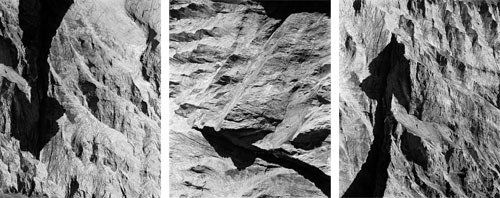Guido Baselgia
dal 18/1/2012 al 9/3/2012
Segnalato da
18/1/2012
Guido Baselgia
Galerie Andres Thalmann , Zurich
The title of the show - AlpenFalten (Alpine Folds) - refers to the glaciation, the creation of the Alps and their slow disappearance. He creates photos combining proximity and distance, and rendering palpable the flow of time.

Guido Baselgia is a photographer. But what pulls him is not the naturalistic reproduction of a landscape. Shouldering his large-format camera, he invests heavily in his works, the result of lonely marches across empty landscapes. In all weather, in complete silence and isolation he communes with what he sees, tenaciously struggling to achieve his vision. The Swiss Engadine and the Bolivian Altiplano, Chile’s Atacama desert, the Far North with its fjords and polar seas, the world’s oceans, the sun and the stars provide his scenery and backdrops. The title of Baselgia’s show – AlpenFalten (Alpine Folds) – refers to the glaciation, the creation of the Alps and their slow disappearance. This time, he has taken to the air to create works combining proximity and distance, and rendering palpable the flow of time, a philosophical dimension that is always present in Baselgia’s work.
Ernst Ludwig Kirchner painted them, Conrad Ferdinand Meyer’s poetry celebrated them: the peaks of Bergün, and in particular the Tinzenhorn, “the small dazzling peak“(*) that forms a magical dolomite triad with Piz Ela and Piz Mitgel in the Grisons Albula valley. Guido Baselgia cannot resist these striking mountains. In his latest works he confronts them at eye level. Airborne and circling the mountains, the photographer does not seek to capture monumental awe but takes a subtle approach to the sheer cliff-faces’ rugged beauty. In this manner, four large-scale works have been created. Despite their painstakingly high definition of these images, they go far beyond an exact reproduction as their vast size imparts on the viewer a sense of immediate presence.
Piz Ela, the tallest of the three peaks, carries the wing, carries flight in its name. This mountain, too, is folded into precipitous chasms and gentler moraines. In his second panoramic image and from his aerial vantage point, Baselgia focuses on the relative nature of point of view and on the passing of time. In flight the striking background appears to remain immobile and immutable, while the foreground changes continuously, each photograph producing a new view and revealing geological dimensions. Vast and minute objects become interchangeable; proximity and distance both depend on and cancel each other out. None of these images can be recaptured; everything is in constant flux, changing continuously.
Baselgia’s glacier works in neutral LED lightboxes are his most recent. The series transforms the analogue into digital images. Again, the artist has used a large-format camera; he also exploits the translucence of the silver grain. The glass negative becomes a projection surface which releases the image. As he cautiously stepped across the glacier, the photographer perceived the rigid beauty of the ice. In these images, the interior of the Morteratsch glacier vaults outward, ist jagged folds and soft waves shot through with light. Negative reverts into positive. A radiant
image appears whose luminosity lingers even when the power has been cut off. The continuous shift and change from one state into another, from water into ice, also appears to be visible and even audible – at least if one imagines the sound of water dripping off the melting ice.
In the triptych Calanda a black arrow, a shadow, a bird appears to be floating across the rocky plain. Here, Baselgia has created the optical illusion of shifting the perspective; the mountain appears to be tipping into the plain. Whether the image is “up” or “down” becomes irrelevant – any position is “right“. What looks concave turns convex, outside and inside become interchangeable – an illusion is transformed into image. Like a woodcut in its clarity and presence, the black-and-white photograph is striking.
Gisela Kuoni
*"Ein blendendes Spitzchen blickt über den Wald / Das ruft mich, das zieht mich, das tut mir Gewalt", in: C.F. Meyer, im Gedicht Das weisse Spitzchen
Translator’s note: C. F. Meyer, Swiss poet and novelist, 1825-1898. The quotation can be translated thus: "A small dazzling peak flashes over the woodland / It calls me, it pulls me, it forces my soul"
Image: Calanda 1 (Triptych) - 2011, Gelatin silver print on baryta paper, each 60 x 50 cm
Opening 19 January 2012, 18-20 p.m.
Galerie Andres Thalmann
Talstrasse 66 CH-8001 Zürich
Monday - Friday 11 a.m. - 6:30 p.m.
Saturday 11 a.m. - 4 p.m.
or by appointment



